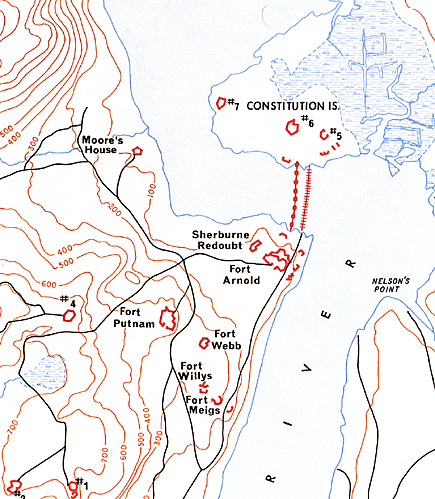Americans should have taken immediate action to build new and better fortifications in the Highlands after Henry Clinton retired to New York. They did little, however, during the remainder of 1777, even though the majority of the Americans wanted to abandon Forts Montgomery and Clinton and build a new fortification at West Point. Expert opinon held otherwise: Washington's chief engineer in the Highlands, French Lieutenant Colonel Louis de la Radiere, did not agree. He wanted to fortify the Fort Clinton area again. After much discussion, Israel Putnam, George Clinton, and James Clinton prevailed: West Point would be fortified. Finally, in mid-January 1778, La Radiere outlined the trace of a new fort on the plateau at West Point, beginning a new era in the Highlands. Later in the month American soldiers marched across the river to West Point for the first time, and established a post which has been occupied continuously ever since.
While Washington and his troops suffered through the winter at Valley Forge, Americans at West Point did little to ensure that the vital waterway would be closed come spring. Arguments between La Radiere and the American leaders, reminiscent of earlier squabbles on Constitution Island, produced few tangible results. In one area, however, the Patriots progressed: the determined young engineer, Thomas Machin, moved ahead with details of building a new chain to span the river between West Point and Constitution Island.
In March 1778, things began to improve at West Point. Colonel Thaddeus Kosciuszko, a French-trained Polish engineer who had won laurels at Ticonderoga and Saratoga, arrived by order of the Continental Congress to assume the duties of Chief Engineer. Kosciuszko, however, immediately clashed with La Radi6re. Washington tried to encourage the two engineers to work together, but in late April he finally replaced La Radi6re with Kosciuszko. West Point now had an expert engineer who could organize the massive undertaking ahead. Under Kosciuczko's supervision and with support of more dedicated commanders, a fortified area began to take shape at West Point. Soldiers built new fortifications to the west and along the ridgeline to the southwest of the original fort drawn on the plain by La Radiere. As the construction got well underway in April, Thomas Machin emplaced the Great Chain between West Point and Constitution Island.
On the plain at West Point, Brigadier General James Clinton with New York Militia and Continental soldiers worked on the main fort on the river - soon to be named Fort Arnold (see Map 2) - and its river line batteries: Chain, Lanthorn, Green, and South.* [* Sometimes called Chain, Lanthorn. (also Lantern. Lanthern), Water and Knox Batteries.] Just to the west other soldiers built a major position, Sherburne Redoubt. Farther west, above the plain, Colonel Rufus Putnam's 5th Massachusetts Regiment threw up the fort which would eventually bear his name. And along the ridgeline south of Fgrt Arnold and covered by Fort Putnam, three Connecticut Regiments built Forts Webb, Wyllys, and Meigs, naming them after their colonels: Samuel Webb, Samuel Wyllys, and Return Jonathan Mei.-S.
The fortifications at West Point reached their fullest development by 1779, after additional redoubts were completed. Apparently Kosciuszko planned to build Redoubt #4 west of Fort Putnam in 1778, but the Americans did not construct it until 1779. That same year the garrison built the southern and western redoubts - #1, #2, #3 with their batteries and outlying works. These new fortifications added depth to the West Point position and protected approaches to Fort Putnam, which was the key to the defense of Fort Arnold and the lower positions on the river';s edge. Redoubt #4 was critical to the defense of Fort Putnam because it stood on higher ground where enemy cannon could be placed to fire into Fort Putnam below. In addition to adding to the defensive strength of the overall position, Battery #1, below Redoubt #1, was capable of firing on enemy ships coming up the Hudson.
On Constitution Island, which the Americans reoccupied in 1778, soldiers partially rebuilt Marine Battery and Gravel Hill Batteries to cover the river line and the chain. They also constructed Redoubts #5, #6, and #7 along the crest of the island to protect the vital river batteries from attack from the landward approach, just as they constructed the western redoubts to protect Forts Putnam and Arnold. By the same time, the soldiers had completed North and South (Middle) Redoubts on the high ridge above the east shore, across from West Point.
When the Americans had completed the forts, redoubts, and batteries, West Point with the chain installed, blocked the Hudson, discouraging a repetition of Sir Henry Clinton's 1777 Campaign. As a fortress, West Point was much ahead of its time, because as 19th and 20th century soldiers discovered, a fortified area consisting of mutually supporting strong points is the heart of modern defensive positions and is considerably stronger than a single position built in the 18th century tradition.

More History of West Point
-
Introduction
1775: Constitution Island
1776: Twin Forts of the Popolopen
1777: Defeat in the Highlands
1778: Fortifications of West Point
1779: Stony Point
1780: Treason
1781-83: Yorktown to Peace
1802: US Military Academy
Back to War Lore: The List
Back to Master Magazine List
© Copyright 2001 by Coalition Web, Inc.
This article appears in MagWeb (Magazine Web) on the Internet World Wide Web.
Other military history articles and gaming articles are available at http://www.magweb.com